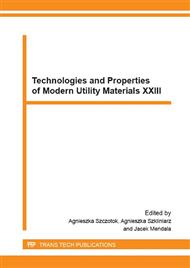[1]
J.P. Shingledecker, N.D. Evans, Creep-rupture performance of 0. 07C–23Cr–45Ni–6W–Ti, Nb austenitic alloy (HR6W) tubes, Int. J. Pres. Ves. Pip. 87 (2010) 345-350.
DOI: 10.1016/j.ijpvp.2010.03.011
Google Scholar
[2]
S.H. Cui, Z. Zhang, Y. Xu, J. Li, X. Xiao, Ch. Zhu, Improvement of stress–rupture life for modified–HR6W austenitic stainless steel, J. Mater. Sci. Technol. 27 (11) (2011) 1059-1064.
DOI: 10.1016/s1005-0302(11)60186-2
Google Scholar
[3]
T. Tokairin, K.V. Dahl, H.K. Danielson, F.B. Grumsen, T. Sato, J. Hald, Investigation on long–term creep rupture properties and microstructure stability of Fe–Ni based alloy Ni–23Cr–7W at 700°C, Mat. Sci. Eng. A–Struct. 565 (2013) 285-291.
DOI: 10.1016/j.msea.2012.12.019
Google Scholar
[4]
Y. Noguchi, H. Okada, H. Semba, M. Yoshizawa, Isothermal, thermo–mechanical and bithermal fatigue life of Ni base alloy HR6W for piping in 700°C USC power plants, Procedia Eng. 10 (2011) 1127-1132.
DOI: 10.1016/j.proeng.2011.04.186
Google Scholar
[5]
H. Hirata, H. Ogawa, Y. Yoshizawa, T. Ono, K. Yotoku, H. Okada, Stress relaxation cracking susceptbility of 23Cr–45Ni–7W alloy for advanced high efficient power plant, Proc. of 3rd International Conference Powerwelding, Ostaniec, 2013, 275-284.
Google Scholar
[6]
K. Cieszyński, B. Rutkowski, J. Jelita–Rydel, G. Cempura, A. Czyrska-Filemonowicz, Influence of high temperature on the microstructure of HR6W nickel-base alloy, Materials 6th HIDA Conference on Defect Assesment and Failure in High temperature Plant, Nagoya (2013).
Google Scholar
[7]
A. Hernas, P. Jamrozik, J. Pasternak, S. Fudali, Characteristics of the structure of welded joints in HR6W alloy, Energetyka - Publisher Association of Polish Engineers SEP, 11 (2012) 687-692.
Google Scholar
[8]
P. Jamrozik, K. Sieczkowski, Characteristics of the structure and basic mechanical properties of welded joints in HR6W alloy, in: XVI International Students' Scientific Session, Silesian University of Technology, Katowice, Poland, 2014, pp.45-48.
Google Scholar
[9]
M. Lipińska–Chwałek, M.G. Stein–Brzozowska, B. Rutkowski, A. Gil, J. Maier, A. Czyrska–Filemonowicz, Microstructural aspects of the fire-side corrosion of HR6W and Sanicro 25 austenitic alloys, Proceedings of 10th Liege Conference, Liege, Belgium, 2014, pp.737-745.
Google Scholar
[10]
S. Muneki, H. Okuba, F. Abe, Creep property of carbon and nitrogen free high strength new alloys, Int. J. Pres. Ves. Pip. 87 (2010) 351-356.
DOI: 10.1016/j.ijpvp.2010.03.015
Google Scholar
[11]
M. Tabuchi, H. Hongo, F. Abe, Creep strength of dissimilar welds for advanced USC boiler materials, Proc. of 13th International Conference on Fracture, Beijing, China, June 16-21, 2013, pp.1-7.
DOI: 10.1115/pvp2013-97659
Google Scholar
[12]
R. Rautio, S. Bruce, Alloy for ultracupercritical coal fired boilers, Adv. Mater. Process. 166 (4) (2008) 35-37.
Google Scholar
[13]
M. Jafarzadegan, A.H. Feng, A. Abdollah–Zadeh, T. Saeid, J. Shen, H. Assadi, Microstructure and mechanical properties of a dissimilar friction stir weld between austenitic stainless steel and low carbon steel, J. Mater. Sci. Technol. 29 (4) (2013).
DOI: 10.1016/j.jmst.2013.02.008
Google Scholar


